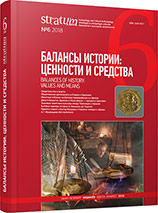Социальные маркеры русского служилого населения Западной Сибири XVII—XVIII вв. по археологическим материалам. Табак и трубки
Social Markers of the Russian Servicemen in Western Siberia in 17th—18th Centuries by Archaeological Materials. Tobacco and Pipes
Author(s): Larisa V. Tataurova, Philip S. TataurovSubject(s): History, Archaeology, Social history, Modern Age, 17th Century, 18th Century
Published by: Издательский дом Stratum, Университет «Высшая антропологическая школа»
Keywords: Western Siberia; 17th—18th centuries; archeology of Russians; social markers; tobacco; pipes
Summary/Abstract: During the process of colonization and development of the Western Siberia by the Russians, the social structure of the population of the region was formed by service class people. The predominance of the military people was necessary for the colonization strategy. The service class people tried to emphasize their status in various ways, for example, by acquiring fashion habits such as tobacco smoking. Tobacco was an expensive and forbidden commodity and, because of this, prestigious. Habits are one of social markers which shaped the social and cultural appearance of the service class population. The author of the article analyzes smoking accessories which were obtained during archaeological excavations of rural settlements founded by service class people of Omsk (the Irtysh basin) and draws some conclusions about the role of tobacco and pipes as social markers.
Journal: Stratum plus. Археология и культурная антропология
- Issue Year: 2018
- Issue No: 6
- Page Range: 309-317
- Page Count: 9
- Language: Russian
- Content File-PDF

